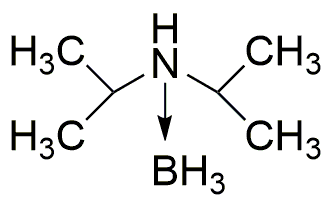Diisopropylamine borane is widely utilized in research focused on:
- Reducing Agents: It serves as an effective reducing agent in organic synthesis, helping to convert carbonyl compounds into alcohols, which is crucial in pharmaceuticals and fine chemicals.
- Hydrogen Storage: This compound is explored for its potential in hydrogen storage systems, providing a safe and efficient way to store hydrogen for fuel cells and energy applications.
- Polymer Chemistry: It is used in the synthesis of polymers, enhancing properties such as flexibility and strength, making it valuable in the production of advanced materials.
- Catalysis: Diisopropylamine borane acts as a catalyst in various chemical reactions, improving reaction rates and yields, which is essential in industrial processes.
- Pharmaceutical Development: Its role in drug formulation and development is significant, particularly in creating compounds with better bioavailability and efficacy.
General Information
Properties
Safety and Regulations
Applications
Diisopropylamine borane is widely utilized in research focused on:
- Reducing Agents: It serves as an effective reducing agent in organic synthesis, helping to convert carbonyl compounds into alcohols, which is crucial in pharmaceuticals and fine chemicals.
- Hydrogen Storage: This compound is explored for its potential in hydrogen storage systems, providing a safe and efficient way to store hydrogen for fuel cells and energy applications.
- Polymer Chemistry: It is used in the synthesis of polymers, enhancing properties such as flexibility and strength, making it valuable in the production of advanced materials.
- Catalysis: Diisopropylamine borane acts as a catalyst in various chemical reactions, improving reaction rates and yields, which is essential in industrial processes.
- Pharmaceutical Development: Its role in drug formulation and development is significant, particularly in creating compounds with better bioavailability and efficacy.
Documents
Safety Data Sheets (SDS)
The SDS provides comprehensive safety information on handling, storage, and disposal of the product.
Product Specification (PS)
The PS provides a comprehensive breakdown of the product’s properties, including chemical composition, physical state, purity, and storage requirements. It also details acceptable quality ranges and the product's intended applications.
Certificates of Analysis (COA)
Search for Certificates of Analysis (COA) by entering the products Lot Number. Lot and Batch Numbers can be found on a product’s label following the words ‘Lot’ or ‘Batch’.
Numéro de catalogue
Numéro de lot/série
Certificates Of Origin (COO)
This COO confirms the country where the product was manufactured, and also details the materials and components used in it and whether it is derived from natural, synthetic, or other specific sources. This certificate may be required for customs, trade, and regulatory compliance.
Numéro de catalogue
Numéro de lot/série
Safety Data Sheets (SDS)
The SDS provides comprehensive safety information on handling, storage, and disposal of the product.
DownloadProduct Specification (PS)
The PS provides a comprehensive breakdown of the product’s properties, including chemical composition, physical state, purity, and storage requirements. It also details acceptable quality ranges and the product's intended applications.
DownloadCertificates of Analysis (COA)
Search for Certificates of Analysis (COA) by entering the products Lot Number. Lot and Batch Numbers can be found on a product’s label following the words ‘Lot’ or ‘Batch’.
Numéro de catalogue
Numéro de lot/série
Certificates Of Origin (COO)
This COO confirms the country where the product was manufactured, and also details the materials and components used in it and whether it is derived from natural, synthetic, or other specific sources. This certificate may be required for customs, trade, and regulatory compliance.


